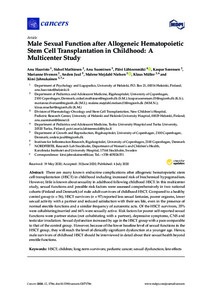Male Sexual Function after Allogeneic Hematopoietic Stem Cell Transplantation in Childhood: A Multicenter Study
Anu Haavisto; Sidsel Mathiesen; Anu Suominen; Päivi Lähteenmäki; Kaspar Sørensen; Marianne Ifversen; Anders Juul; Malene Mejdahl Nielsen; Klaus Müller; Kirsi Jahnukainen
Male Sexual Function after Allogeneic Hematopoietic Stem Cell Transplantation in Childhood: A Multicenter Study
Anu Haavisto
Sidsel Mathiesen
Anu Suominen
Päivi Lähteenmäki
Kaspar Sørensen
Marianne Ifversen
Anders Juul
Malene Mejdahl Nielsen
Klaus Müller
Kirsi Jahnukainen
MDPI
Julkaisun pysyvä osoite on:
https://urn.fi/URN:NBN:fi-fe2021042821039
https://urn.fi/URN:NBN:fi-fe2021042821039
Tiivistelmä
There are many known endocrine complications after allogeneic hematopoietic stem cell transplantation (HSCT) in childhood including increased risk of biochemical hypogonadism. However, little is known about sexuality in adulthood following childhood HSCT. In this multicenter study, sexual functions and possible risk factors were assessed comprehensively in two national cohorts (Finland and Denmark) of male adult survivors of childhood HSCT. Compared to a healthy control group (n= 56), HSCT survivors (n= 97) reported less sexual fantasies, poorer orgasms, lower sexual activity with a partner and reduced satisfaction with their sex life, even in the presence of normal erectile functions and a similar frequency of autoerotic acts. Of the HSCT survivors, 35% were cohabitating/married and 66% were sexually active. Risk factors for poorer self-reported sexual functions were partner status (not cohabitating with a partner), depressive symptoms, CNS and testicular irradiation. Sexual dysfunction increased by age in the HSCT group with a pace comparable to that of the control group. However, because of the lower baseline level of sexual functions in the HSCT group, they will reach the level of clinically significant dysfunction at a younger age. Hence, male survivors of childhood HSCT should be interviewed in detail about their sexual health beyond erectile functions.
Kokoelmat
- Rinnakkaistallenteet [27094]
